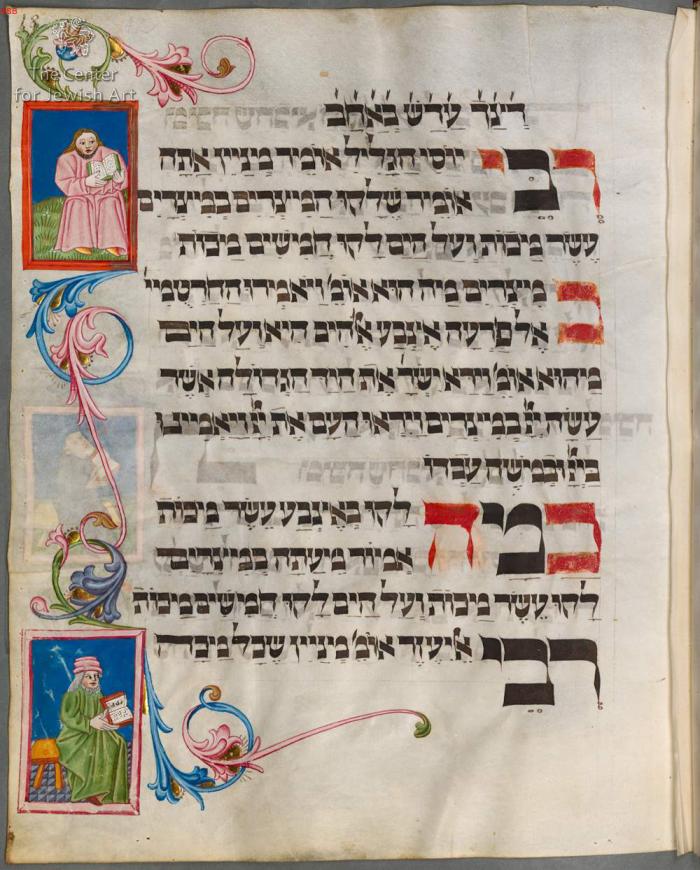Img. ID: 199994

Fol. 18: Two panels depicting two Rabbis from the haggadah, both holding an open book, in the upper and lower part of the outer margin.
The upper panel, next to the text of Rabbi Yossei the Galilean, depicts a bearded man holding out an open book, seated in a green meadow against a blue sky.
The second panel, extending into the lower margin, shows Rabbi Eliezer, one of the five rabbis of Bnei Brak, seated on a bench and holding an open book inscribed with Hebrew-like squiggles. He has long grey hair and beard, and a three-tiered magenta hat.
Elongated foliate scrolls extend from both the upper and lower sides of the frames, interlacing along the space between the panels.
See: General Document for acanthus branches.
| Cod. hebr. 200 (Steinschneider 1895, No. 200)
H | Haggadah, Passover (Listed according to the text of the Haggadah; See also separate biblical subjects in this list) | The Main part of the Haggadah (arranged with the Ritual Acts (Seder Signs) interspersed with the main components of the text of the Haggadah): | Maggid (the narration) | Maggid-4: Ma`aseh be-Rabbi Eli`ezer (It is told of R. Eliezer) | Rabbis, the Five, of Bene Beraq | Rabbi Eliezer (Rabbis, the Five)
A | Acanthus scroll
|
Fig. 1: Rabbi Yossei
Tegernsee Haggadah
Munich, BSB Cod. hebr. 200, fol. 18
Fig. 2: Rabbi Yossei
Murphy Haggadah
by Joel ben Simeon
North Italy, c.1455
Jerusalem, NLI 406130, fol. 15
(Murphy Haggadah, facsimile n.d.)
Fig. 3: Rabbi Eliezer of Bnei Brak
Floersheim Haggadah
North Italy, 1502
Zurich, Floersheim Coll. no sign., p. 13
(Floersheim Haggadah, facsimile 1985)
Fig. 4: Rabbi Eliezer of Bnei Brak
Tegernsee Haggadah
Munich, BSB Cod. hebr. 200, fol. 18
Fig. 5: Rabbi Eleazar ben Azariah of Bnei Brak
Rylands Sephardi Haggadah
Catalonia, mid-14th century
Manchester, John Rylands Library Heb. 6, fol. 22v
(Loewe, facsimile 1988)
The iconography of rabbis who are mentioned in the text of the haggadah is similar in Sephardi and Ashkenazi haggadot of all periods. It usually has a bearded man sitting on a bench, holding an open book (figs. 1, 2, 4, 5). In most cases the rabbis are depicted in three-quarters view or in profile, but are sometimes shown frontally (figs. 1, 3).
See also fols. 18v and 20v.
See: General Document for acanthus branches.



